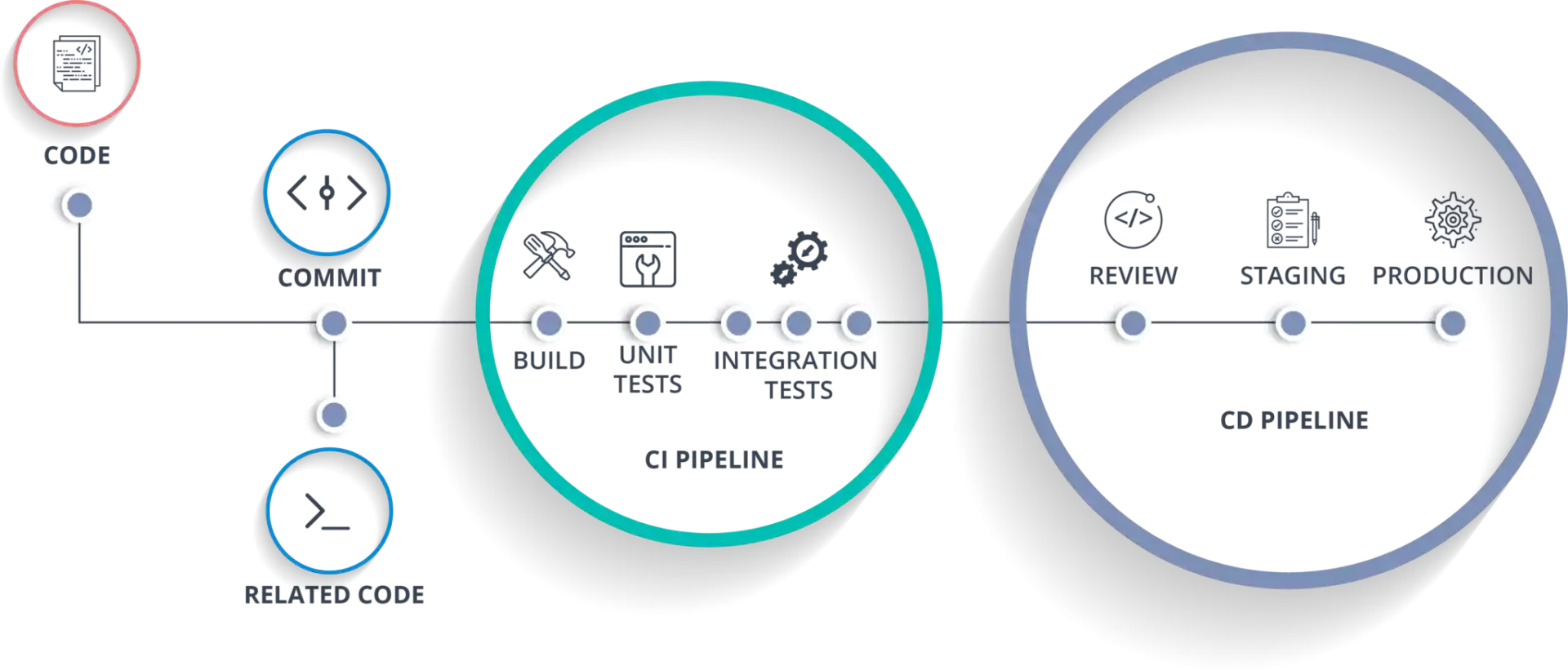Table of Contents
In today’s fast-paced software development landscape, efficiency and speed are paramount. Continuous Integration (CI) and Continuous Deployment (CD) have emerged as essential practices, enabling teams to deliver code changes frequently and reliably. CI ensures early error detection by integrating code changes into a shared repository multiple times a day, while CD automates deployment, swiftly releasing changes into production environments.
This blog explores the essence of CI/CD, highlighting its benefits, and detailing key tools and practices for developers and organizations to maximize its potential. From foundational principles to real-world case studies, we delve into strategies empowering teams to achieve continuous delivery with confidence and efficiency. Join us as we revolutionize software development, navigating the transformative impact of CI/CD and providing actionable insights for innovation in the digital era.

What is CI/CD?
It is a methodology that combines the practices of Continuous Integration (CI) and Continuous Deployment (CD) to automate the steps in software delivery. Here’s a closer look at each component:
- Continuous Integration (CI) encourages developers to merge their changes back to the main branch as often as possible. Each merge triggers an automated build and test sequence for the project, facilitating early detection of integration errors.
- Continuous Delivery (CD) automates the delivery of applications to selected infrastructure environments. Most teams work with multiple environments other than production, such as development and testing environments, and CD ensures there is an automated way to push code changes to them.
- Continuous Deployment goes one step further by automatically deploying every change that passes through the pipeline to production, enabling a truly automated pathway from the developer’s machine to the end user.
Key CI/CD Tools
Integrating CI/CD into your development process requires tools that fit your project’s needs. Below are examples of tools that facilitate CI/CD practices, categorized by their primary function:
Continuous Integration Tools
- Jenkins: An open-source automation server that provides hundreds of plugins to support building, deploying, and automating any project. Jenkins is highly customizable and widely used, making it a staple in many toolchains.
- Travis CI: A hosted continuous integration service used to build and test software projects hosted at GitHub and Bitbucket. Travis CI automatically detects when a commit has been made and pushed to a GitHub repository and then attempts to build the project and run tests.
- GitLab CI/CD: Part of the GitLab platform, it offers a seamless experience integrated into your Git repository. It’s especially powerful for GitLab users, enabling them to define their configuration in their Git repository itself.
Continuous Deployment Tools
- CircleCI: Offers cloud-based CI/CD that works seamlessly with GitHub, Bitbucket, and GitLab. It’s known for its speed and efficiency, allowing for rapid software releases.
- Heroku CI: A continuous integration service that is tightly integrated with Heroku’s platform. It automatically runs your tests in a disposable Heroku app instance, providing simplicity for developers deploying to Heroku.
- AWS CodePipeline: A continuous delivery service that automates the build, test, and deploy phases of your release process. It integrates with AWS services such as AWS CodeBuild, AWS CodeDeploy, and others, enabling a smooth transition from code to deployment on AWS infrastructure.
Best Practices for Implementing CI/CD
- Automate as much as possible: From code integration, and testing, to deployment, aim for full automation to reduce manual intervention and errors.
- Maintain high code quality: Enforce code review standards and integrate automated code quality checks into your CI pipeline.
- Implement a robust testing strategy: Utilize various forms of automated testing, such as unit, integration, and end-to-end tests, to ensure that your application is thoroughly tested at every stage of the CI/CD pipeline.
- Monitor deployments and operations: Use monitoring and logging tools to keep track of your application’s performance and health post-deployment. This will enable you to quickly address any issues that arise.
Conclusion
CI/CD practices are transformative, offering a pathway to enhance software development processes significantly. By embracing the core principles of CI/CD, such as continuous integration, automated testing, and continuous deployment, teams can streamline their workflows and accelerate the delivery of high-quality software. Utilizing the appropriate tools, whether it be Jenkins, GitLab CI, or others, further empowers teams to automate mundane tasks, reduce errors, and foster collaboration across the development lifecycle.
Furthermore, adhering to best practices, such as version control, infrastructure as code, and monitoring, ensures that CI/CD pipelines operate smoothly and reliably. This holistic approach not only improves efficiency but also enhances product quality and customer satisfaction. With CI/CD, teams can iterate faster, respond to feedback more effectively, and deliver features to the market with confidence.
As the software development landscape continues to evolve, the adoption of CI/CD will undoubtedly be a critical factor in maintaining competitiveness and delivering value at the speed of demand. By continuously refining their CI/CD practices and embracing emerging technologies, teams can stay ahead of the curve, adapt to changing market conditions, and drive innovation in the digital age. Unlocking the full potential of CI/CD is not just about adopting a set of tools; it’s about fostering a culture of continuous improvement and collaboration that propels teams toward success in an ever-changing landscape.